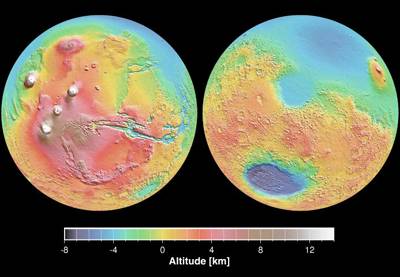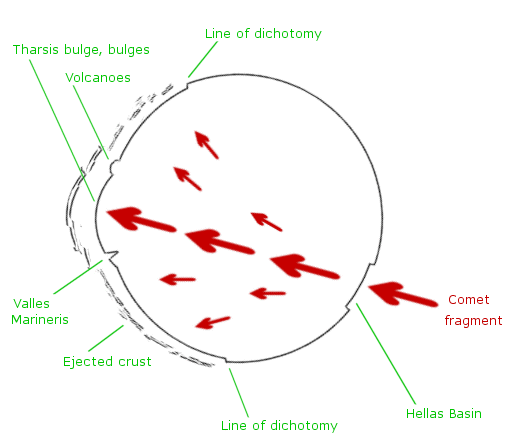In the February 14 issue of the journal Science, Caltech planetary science professor Andy Ingersoll and his graduate student, Shane Byrne, present evidence that the 1966 model of the polar caps being made of frozen carbon dioxid, the so-called "dry ice" is in error.
Scientists at the time argued that the ice caps themselves were solid dry ice and that the caps regulate the atmospheric pressure by evaporation and condensation. Despite later observations by the Viking spacecraft showing that the north polar cap contained water ice underneath its dry ice covering, most scientists maintained that that the south polar cap if not the north cap was made of dry ice.
However, recent high-resolution and thermal images from the Mars Global Surveyor and Mars Odyssey, respectively, show high-resolution images of flat-floored, circular pits eight meters deep and 200 to 1,000 meters in diameter at the south polar cap, and an outward growth rate of about one to three meters per year, which are indicative that under a layer of dry ice, the south cap too mostly contains water ice.
Further, new infrared measurements from the newly arrived Mars Odyssey show that the lower material heats up, as water ice is expected to do in the Martian summer, and that the polar cap is too warm to be dry ice.
This shows that the south polar cap is actually similar to the north pole, which was determined, on the basis of Viking data, to lose its one-meter covering of dry ice each summer, exposing the water ice underneath.
The new results show that the difference between the two poles is that the south pole dry-ice cover is slightly thicker-about eight meters-and does not disappear entirely during the summertime.
It also shows that there is less carbon dioxid on Mars than previously thought, which makes scientists wonder how could have been warm and wet in the past without enough carbon dioxid to create a greenhouse effect.
May I suggest that Mars was hit once by a comet in such a terrific manner that its atmosphere was ruined and most of it escaped in space, along with most of the water and lots of surface material?
Here is the topography of Mars (from MOLA, credit NASA):

|
At the right on the south, the large blue zone is Hellas basin, 1600 by 2000 kilometers wide, an 5 km lower than the surrounding surface. This is where a large comet fragment hit Mars. On the other side of Mars, on the opposite of the impact basin, are leveated suface zones cause by the impact, and the huge crack of Valles Marineris, and huge volcanoes. Other parts of the surface, the low lands on the north, have been wiped out by the impact. This is obvious as there are much less meteor craters than on the older higher terrains in the south. And along the disaster zones, huge flows have carved gigantic valleys, much larger than usual rivers on Earth.
A picture is sometimes better than a thousand words; this is how it worked:

|
Think about it.